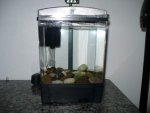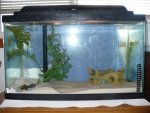xXNetRavenXx
New member
- Joined
- Apr 22, 2009
- Messages
- 46
- Reaction score
- 2
- Points
- 0
- Country
- United States
Okay so I just had a loss of a young axie due to stress, now I am getting back in the saddle again and getting two new ones from wards natural science (shipping soon so tomorrow or monday  )
)
Sooo my old tank that I had my other axie in was a 20gal tank with sand substrate and some little tidbits (plant, hiding spot)
I wonder if I should just take the substrate out and use the bare floor? Also I have a small tank that I just bought for a fish we had that got moved from the big tank to make room for the axie.... That tank is pretty small (like 2gal) but it has a filter and is pretty decent, I wonder if that would be a better habitat for my future axoltols?

Cant wait till they get here
Sooo my old tank that I had my other axie in was a 20gal tank with sand substrate and some little tidbits (plant, hiding spot)
I wonder if I should just take the substrate out and use the bare floor? Also I have a small tank that I just bought for a fish we had that got moved from the big tank to make room for the axie.... That tank is pretty small (like 2gal) but it has a filter and is pretty decent, I wonder if that would be a better habitat for my future axoltols?
Cant wait till they get here


